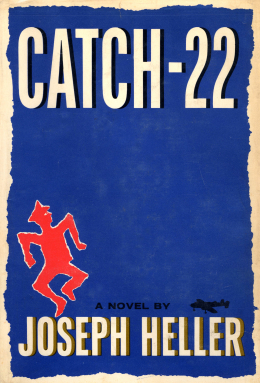Catch-22

Catch-22 is a satirical war novel by American author Joseph Heller. He began writing it in 1953; the novel was first published in 1961. Often cited as one of the most significant novels of the twentieth century,[2] it uses a distinctive non-chronological third-person omniscient narration, describing events from the points of view of different characters. The separate storylines are out of sequence so the timeline develops along with the plot.
The novel is set during World War II, from 1942 to 1944. It mainly follows the life of antihero Captain John Yossarian, a U.S. Army Air Forces B-25 bombardier. Most of the events in the book occur while the fictional 256th US Army Air Squadron is based on the island of Pianosa, in the Mediterranean Sea west of Italy, though it also covers episodes from basic training at Lowry Field in Colorado and Air Corps training at Santa Ana Army Air Base in California. (In reality, the USAAF did not use the B-25 in combat in the European theater of operations, only the RAF did.) The novel examines the absurdity of war and military life through the experiences of Yossarian and his cohorts, who attempt to maintain their sanity while fulfilling their service requirements so that they may return home.
The book was made into a film adaptation in 1970, directed by Mike Nichols. In 1994, Heller published a sequel to the 1961 novel entitled Closing Time.
The development of the novel can be split into segments. The first (chapters 1–11) broadly follows the story fragmented between characters, but in a single chronological time in 1944. The second (chapters 12–20) flashes back to focus primarily on the “Great Big Siege of Bologna” before once again jumping to the chronological present of 1944 in the third part (chapter 21–25). The fourth (chapters 26–28) flashes back to the origins and growth of Milo’s syndicate, with the fifth part (chapter 28–32) returning again to the narrative present and maintaining the tone of the previous four. The sixth and final part (chapter 32 and on) remains in the story’s present, but takes a much darker turn and spends the remaining chapters focusing on the serious and brutal nature of war and life in general.[3] Previously the reader had been cushioned from experiencing the full horror of events, but in the final section, the events are laid bare. The horror begins with the attack on the undefended Italian mountain village, with the following chapters involving despair (Doc Daneeka and the Chaplain), disappearance in combat (Orr and Clevinger), disappearance caused by the army (Dunbar) or death of most of Yossarian’s friends (Nately, McWatt, Kid Sampson, Dobbs, Chief White Halfoat and Hungry Joe), culminating in the horrors of Chapter 39, in particular the rape and murder of the innocent young woman, Michaela.[3] In Chapter 41 the full details of the gruesome death of Snowden are finally revealed.
Nevertheless, the novel ends on an upbeat note with Yossarian learning of Orr’s miraculous escape to Sweden and Yossarian’s pledge to follow him there.
Many events in the book are repeatedly described from differing points of view, so the reader learns more about each event from each iteration, with the new information often completing a joke, the setup of which was told several chapters previously. The narrative’s events are out of sequence, but events are referred to as if the reader is already familiar with them so that the reader must ultimately piece together a timeline of events. Specific words, phrases, and questions are also repeated frequently, generally to comic effect.[citation needed]
